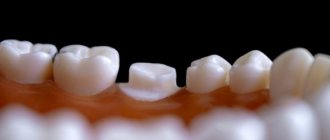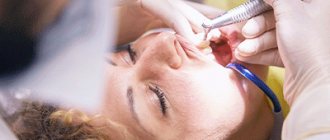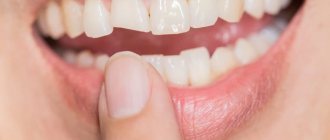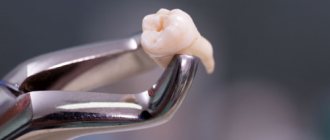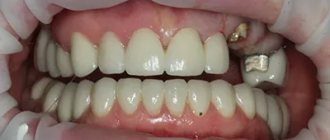- Why and when is extension needed?
- Main indications for extensions
- Extension techniques
- How to grow your front teeth?
- Advantages and disadvantages of extensions
- Contraindications
- FAQ
- Price
- Reviews
Dental augmentation is an effective procedure that can eliminate a number of dental defects most simply and quickly, without resorting to implantation.
It is especially in demand when it comes to the front teeth, the appearance of which ensures the aesthetics of the entire smile area. It is important that if you follow the recommendations, the result obtained will be long-term and will allow you to solve the existing problem for many years. For one patient, the use of such a tooth will be 5, for another – 10 or 20 years. How long an extended tooth lasts depends on many factors, the technique and materials used, the skill of the dentist, and the products included in the diet. Care will also play an important role. Due to the consumption of coffee, red wine, or smoking, the color may change, which will require a repeat event.
At the same time, restoring a tooth without a pin will make it possible to guarantee a longer service life. However, in a number of cases, it will not be possible to do without the use of such a technique to strengthen the affected tooth.
Indications and contraindications for tooth augmentation
Teeth augmentation is a multi-stage technology for restoring the aesthetic appearance and functions of the jaw, which was susceptible to chipping or erased as a result of increased tone of the masticatory muscles, called buxism.
Indications for the tooth augmentation procedure:
- chips resulting from injuries;
- numerous caries lesions;
- large distance between teeth;
- wedge-shaped defect;
- the presence of a gap between the two front teeth;
- congenital structural pathologies;
- thinning and demineralization of enamel due to consumption of junk food and lack of oral hygiene;
- cervical caries;
- the presence of errors in previous dental sessions that resulted in the destruction of healthy tissue;
- malocclusion.
Having asked the dentist a question about what tooth extension is called, the patient will immediately hear the answer. The procedure is called dentition restoration. Modern extension technologies make it possible to restore the structure in most cases without resorting to its removal. The procedure is harmless, but has a number of contraindications:
- patient age – more than 60 years;
- children's age when using pins;
- presence of a cyst;
- inflammation of the gums;
- pregnancy in the first or third trimester;
- failure to comply with personal hygiene rules;
- periodontitis and stomatitis;
- jaw fracture and other injuries.
If a patient is diagnosed with diseases that are contraindications, the dentist first treats them, and then restores the dentition.
Reviews
Your feedback is to help potential patients make the right choice. Leave your suggestions or comments so we can work even better.
LEAVE FEEDBACK
Teeth extension methods
There are 2 main extension methods:
- Straight. Used if tooth decay is up to 30%. During the procedure, composite or photopolymer materials are used to build teeth. The former are less durable and harden after 30 minutes. The latter have a service life of 10 years and remain plastic until exposed to the lamp.
- Indirect. Applicable when damage affects no more than 70% of the structure. The method has several stages, including taking impressions, making and installing ceramic inlays.
If you have ever thought about whether a crown or extension is better, then you should know that a crown is installed when more than 70% of the tissue is destroyed, but a intact and healthy root remains.
Possible complications
Complex injuries can often have serious consequences, manifested in complications. It doesn’t matter which tooth was injured – the front incisor, the chewing tooth. After the examination, the doctor will decide how to save the child’s tooth. If you neglect the recommendations of a specialist, this can lead to more serious consequences, not to mention aesthetics.
Types of complications
1. Possibility of infection of the pulp area.
2. Increased tooth sensitivity.
3. The appearance of a bend in the tooth root.
4. Violation of occlusion.
5. Formation of cysts and granulomas.
You need to prepare for the fact that a damaged child’s tooth will begin to change the angle of development. And this leads to deformation not only of the damaged tooth, but also of its healthy neighbors. If it is necessary to remove a broken tooth, the space must be filled with an implant. If filling is not carried out, other teeth will begin to shift and move closer together, which leads to occlusion disorders - bite.
Features of front teeth extensions
Restoration of anterior teeth is carried out in the following cases:
- Yellowing of enamel;
- Damage to caries;
- Minor curvature;
- Presence of chips or chips;
- Grayish-yellow coating.
Composites and photopolymers are used for extensions, but veneers are the most popular. They are used for minor damage to healthy tissue. If the tooth body is deeply damaged, it is removed from the roots and an implant is implanted in its place. Types of veneers presented in our clinic: composite veneers, ceramic veneers.
Chips of baby teeth often occur in childhood. Many parents do not pay attention to this, hoping for the speedy growth of indigenous children. This is wrong, as the sharp edges scratch the tongue, causing inflammation and infection. Children's extensions are made using composite materials and are absolutely painless.
Recovery methods
Several methods can be used to restore a child's teeth. The type of restoration is chosen by the dentist depending on the nature and degree of destruction.
The difficulty of a dentist’s work during the process of tooth restoration is that children quickly get tired due to the need to remain static in a chair. Therefore, the Natadent Children's Dental Clinic provides the possibility of dental treatment under local anesthesia, general anesthesia or inhalation sedation.
Sealing
If a tooth is partially damaged, the dentist evaluates the condition of the remaining hard tissues and the quality of the soft tissues around the crown and roots. The following filling options are possible:
- treatment of the canals of a baby tooth and placing a filling at the gum level so that the tooth is not in the bite and does not experience stress;
- restoration using filling material.
Light-curing composite materials have many advantages:
- the dentist can completely build up a child’s tooth and recreate the crown relief;
- the chewing surface becomes durable;
- there is no release of harmful substances into the child’s body;
- the material hardens under UV light;
- You can achieve a high cosmetic effect and the required degree of transparency of the filling.
To prevent the formation of cracks during the life of the child and during shrinkage, the dentist forms a filling when building up layer by layer. The composite has the ability to hermetically close any microcracks and firmly connect to dentin.
Light-composite materials are a real innovation in dentistry, with the help of which filling and restoration of teeth has become less traumatic and most effective.
Crown installation
Carrying out this procedure in children is surprising, but not among the specialists at the Natadent clinic.
It is recommended to use the following method:
- for large chips;
- with significant tooth destruction of 50% or more.
If the chewing surface and one of the side walls of the tooth are lost, the remaining thin walls will not withstand the chewing load for a long time.
Installing a crown is a reliable way to save a baby tooth from destruction and maintain its functionality until it is replaced with a permanent one.
Crowns help:
- chew food thoroughly, which is important for the vulnerable gastrointestinal tract system;
- prevent the appearance of persistent speech defects, which is especially important during the period of active development of the child and preparation for school;
- form the correct bite.
Timely protection of teeth with crowns is an opportunity to minimize further destruction of baby teeth, the development of secondary caries and prevent improper development of permanent teeth.
Natadent pediatric dentistry uses two types of crowns:
- ceramic for the front teeth, which do not differ from natural incisors in color and shape and do not violate the aesthetics of the smile;
- metal, made of stainless steel, which are the ideal solution for restoring the function of chewing teeth.
Modern crowns are high-quality products with a unique design; they do not require significant grinding of the tooth, but significantly prolong its life. At the clinics of the Natadent network, we restore teeth for children in the same aesthetic and beautiful way as for adults.
Tooth extension onto a pin
When thinking about whether it is possible to build a tooth onto the root, the use of a pin comes to mind. It is used if both the body and the root are severely damaged.
The procedure includes:
- obtaining an x-ray;
- cleaning the mouth, removing stones;
- removal of damaged areas;
- computer tooth modeling;
- removal of saliva;
- anesthesia;
- cleaning of channels;
- implantation of a pin, cleansing the area around it;
- filling the space around the pin with a composite or photopolymer;
- polishing and grinding.
Dentists build up teeth under crowns only if the remainder is in good condition and does not rot or decompose.
Prevention of tooth decay
We must try to avoid serious dental problems and prevent situations where a child could be injured or break a tooth. Parents should try to minimize all risks. To do this, it is enough to apply a few simple rules in practice.
For proper growth and development of bones and teeth, it is necessary to provide the child with complete, high-quality nutrition. Then the body will receive the entire complex of necessary micronutrients, vitamins, and substances.
When the baby has all his milk teeth, around the age of three, it would be good to give him more solid food. Various vegetables, fruits, and crackers are suitable for this. This way the child will become accustomed to more adult food, which will strengthen his teeth.
To maintain healthy teeth, you need to pay attention to the development of the child’s chewing muscles; for this, you should control the consistency of food.
It is important to teach your child to brush his teeth and instill the good habit of visiting the dentist periodically.
View prices
Making an appointment with a dentist
Does it hurt to grow teeth?
Tooth extension is a painless procedure. Anesthesia is not performed if the damage is not significant, since manipulations are carried out at a superficial level. If the damage is severe, the dentist administers local anesthesia. Modern drugs begin to act immediately after administration.
After the session, the first day you may experience pain if the canals were cleaned. Painkillers will help you feel better.
The restored dentition will last a long time if the patient provides proper care. If the question arises about whether it is possible to smoke after tooth extensions, the answer will be negative. Composite and photopolymer materials quickly absorb all substances, which is why the filling quickly changes color. Maintaining hygiene and regular visits to the dentist will help you maintain your smile for a long time.
Types of chipped teeth
Restoration methods depend on the damage. Dentists distinguish the following types of chipped teeth:
- Incomplete. A barely noticeable crack appears on the enamel, and the rest of the tooth is not affected. The easiest case, which requires purely aesthetic restoration.
- Enamel chip. If a small piece breaks off from a tooth, most likely only the enamel is damaged. If measures are taken quickly, the deep layers of the tooth will not have time to collapse either.
- Dentin chipping. This layer is located under the enamel, inferior to it in hardness, but reliably protects the nerve and pulp. If dentin is damaged, the tooth usually does not hurt; at most, it reacts to acids and cold.
- Chip exposing the pulp. If a tooth is severely cracked, its darker part is visible, and the person is in pain, this means that the pulp, the most sensitive part of the tooth, is damaged. This is where the nerve and blood vessels are located, so bleeding is common. If the pulp is chipped, you need to make an appointment with a doctor as soon as possible. However, when half a tooth chips off, people usually do not postpone the visit.
When should you go to the dentist?
Immediately after receiving an injury, parents need to pull themselves together and try to calm the baby. The first thing you need to do is make a visual inspection, try to carefully clean the oral cavity from food debris, ask the child to rinse his mouth with boiled water at room temperature or a light antiseptic solution. To relieve the pain a little and reduce swelling, you can apply ice wrapped in several layers of napkins to the cheek on the side of the sore spot. If bleeding occurs, apply a piece of sterile bandage to the wound and immediately go to the doctor.
The first step is to ask your child to rinse his mouth.
How much does it cost to fix a chipped tooth?
It happens that people do not seek help because they think that dental restoration is very expensive. In fact, it is easier and cheaper to immediately “fix” a chipped tooth than to wait for bacteria to penetrate through the crack and have to treat pulpitis. Moreover, all our services are available in installments.
In Mira clinics, prices for correction of a chipped tooth start at 2,000 rubles. — this is how much it costs to restore the edges of the front teeth. The final cost of treatment depends on the volume. You can call the clinic and we will tell you how much it costs to fix a chipped tooth in your case. But it’s better, of course, to make an appointment for an inspection - only after assessing the damage can you give an exact price. “Mira” is your dentistry, Krasnoyarsk is not in vain turning to us!
A child's tooth chipped. What to do?
Most often, a child, especially a small one, gets a chip as a result of an impact accompanied by pain. What to do in such a situation?
- First of all, the child needs to be reassured;
- Next, a visual inspection and rinsing the mouth with water is required;
- If the lip is damaged, it should be treated with antiseptics;
- If there is a broken fragment, it must be placed in saline or milk;
- Visit the dentist as quickly as possible. This must be done within 24 hours, or preferably a few hours.
The faster a specialist sees a tooth, the greater the chance of its survival and absence of infections.
Today, there is a broad classification for dental injuries based on etiology and anatomy. The proposed classification is based on the standards of the World Health Association, and is included in the ICD Appendix in the “Dentistry” category.
What experts advise for prevention
As in the case of any other pathological conditions, it is always better to prevent unpleasant consequences than to later engage in long and costly, and sometimes quite painful, treatment. To reduce the risk of damage and destruction of children's primary incisors and molars, it is necessary from an early age to teach the child to take a responsible approach to oral care, brush his teeth every morning and evening, and follow all basic hygiene rules.
It is worth keeping a close eye on your baby while he is playing. Try to exclude all traumatic factors. Later, if the child begins to engage in traumatic sports, he should be given an individual protective mouthguard - this service is provided by many modern dentists.
It is worth keeping a close eye on your baby while he is playing.
But finally, in no case should you ignore any pathological changes in the oral cavity, even if there are only temporary baby incisors and molars. If there is a clear malocclusion, orthodontic treatment should be started promptly. If caries and inflammatory processes develop, immediately show the child to a specialist. Parents need to remember that any advanced dental diseases can easily damage the buds of permanent teeth, which will inevitably affect their condition and health in the future.
1Eradze E.P., Osipov G.A. Modern methods of treating acute dental trauma in children, 2001.
Should I save the piece that fell off?
If part of a tooth breaks off , if possible, you need to find it and take it with you to the appointment. If necessary, the doctor, using modern materials, can glue it back. By fixing a broken fragment, a tooth today can be restored not only to its natural appearance, but also to full functionality. This cannot always be achieved by creating an imitation, albeit an accurate one.
What if a baby tooth breaks off?
The fragment needs to be washed, put in milk, or, in extreme cases, just in water, and immediately go with the child to the clinic. You shouldn’t think that baby teeth will soon be replaced by permanent ones, so you can leave everything as is. If the child does not even complain of pain, an infection can penetrate into the exposed dentin. Sooner or later, inflammation will reach the pulp, and then the periodontium. This will cause a whole chain of further troubles.
In addition, the rudiments of permanent teeth form under the milk teeth, which can also be affected by injury. If the pediatric dentist determines that there is a direct threat to the bud, the baby tooth will most likely be removed.
Dental restoration at the RAIDEN clinic
In case of severe destruction of the tooth wall, when there is no possibility to fill the cavity with filling material, a special rod is installed in the root canal - a standard fiberglass pin, on which a filling or crown is subsequently installed (the pin does not show through and does not oxidize). The fiberglass material of the pin follows the shape of the root and is elastic.
In some clinics in St. Petersburg, tooth extensions are cheaper because patients are given a large filling instead of a dental crown. This risks splitting the tooth down to the root and subsequently removing it. Specialists in the field of aesthetic dentistry "RAIDEN" will not risk your health and install a filling whose size exceeds the permissible standards.
Our dentists are especially careful when building up front teeth, for example, when part of an incisor is chipped. Composite material is used for restoration under the influence of ultraviolet radiation. At the same time, the material is not inferior in strength to a real tooth, does not differ in color, and the joint is absolutely invisible.
Restoration or extension of teeth is carried out in all clinics of the RAIDEN dental network.
Classification of chips and associated symptoms
Dental experts classify chips according to severity. So, a chip of enamel is a minor damage that affects only the top layer. The patient may not experience any pain or discomfort at all.
A chip of enamel is a minor damage
Sometimes the injury affects the dentin, and under it there is a pulp chamber with a bundle of blood vessels and nerve endings. If the damage also affects the pulp, the child will feel severe piercing pain. In such a situation, emergency medical attention is required.
The photo shows teeth with dentin and pulp trauma
A root fracture is a serious injury that can result from a strong blow or fall. The crown breaks, but the root remains inside. With such damage, there is a serious risk of injury to the rudiments of permanent incisors and canines. In all of the above cases, you need the advice and help of a specialist. In this case, the method of treatment and restoration will directly depend on the degree of damage to the visible part and internal structures of the tooth.
Fracture – serious injury to a tooth
The following symptoms often indicate injury - pay attention to them:
- there are complaints of increased sensitivity or the child makes it clear by his behavior that he is experiencing discomfort. He may refuse hot and cold foods, avoid sweets and sour foods, try to chew on one side,
- if the damage reaches the pulp, severe piercing pain occurs,
- discomfort may intensify at night, and this also indicates injury to the pulp,
- Many children acquire the habit of “searching” with their tongue behind their cheek, as if there was something in the mouth.
Severe pain may indicate damage to the pulp.
If you notice one or more of the symptoms described above in a child, ask him, find out if his teeth are bothering him. And be sure to show your baby to a specialist.

